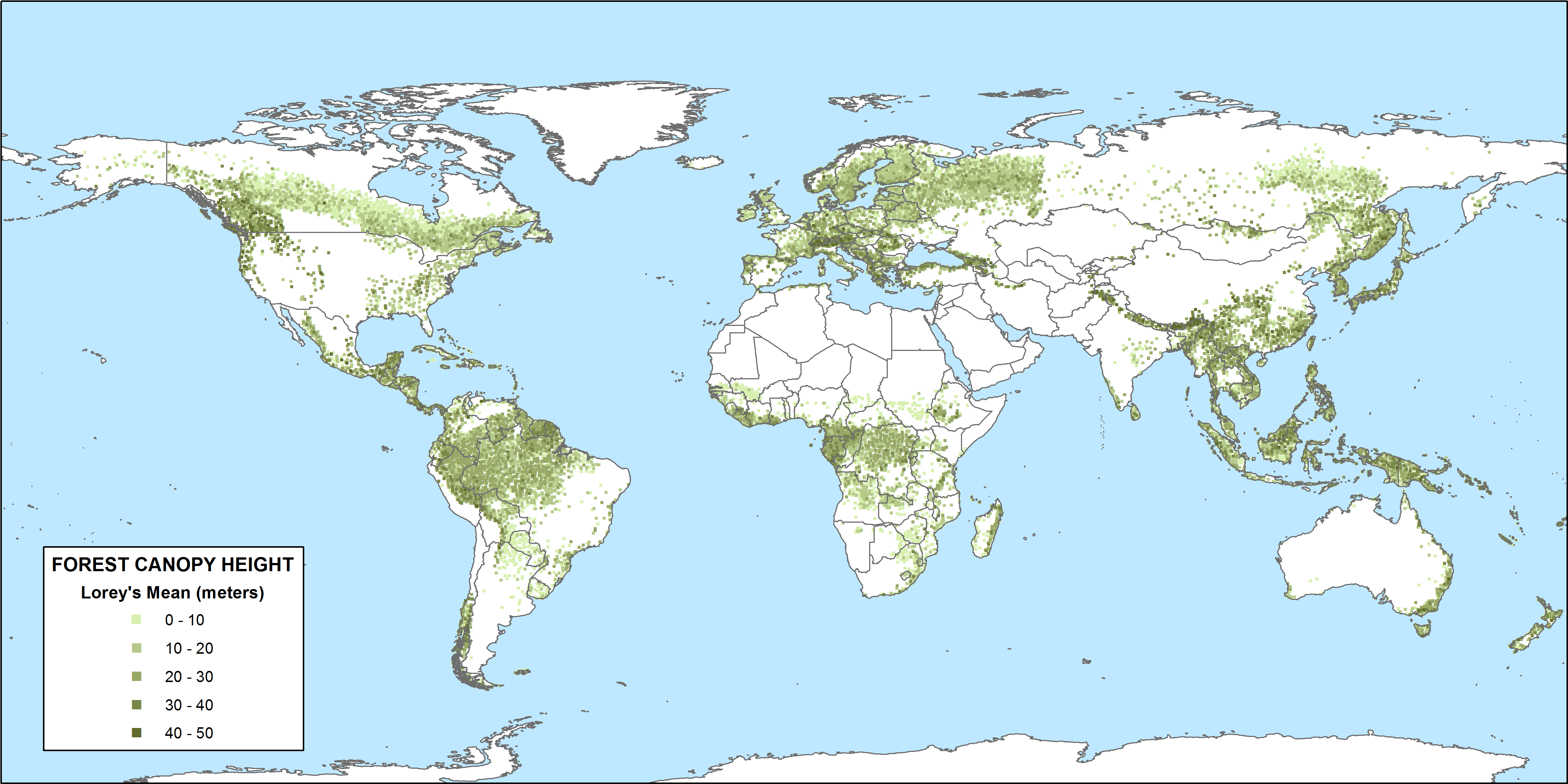Tropical forest canopy height plays a crucial role in the health of our planet’s ecosystems, impacting everything from carbon sequestration to biodiversity. Recent research employing NASA LiDAR technology sheds light on the intricate relationship between climate change and these towering canopies, revealing shifts that may threaten the very forests that act as vital carbon sinks. As taller canopies typically correlate with increased carbon storage, understanding the factors influencing canopy height is essential for assessing overall forest health. This research not only enhances knowledge of how climate change is affecting these critical ecosystems but also emphasizes the urgent need for conservation efforts to protect tropical biodiversity. With the health of Earth’s lungs at stake, insights from this study are timely and vital for policymakers and environmental advocates alike.
The height of trees in tropical forests, often referred to as forest canopy elevation, is key to evaluating the ecological dynamics of these lush landscapes. As scientists explore the implications of climate impact on tree height, it becomes evident that the relationship between canopy elevation and environmental stability is intricate and profound. Utilizing advanced laser scanning techniques, researchers investigate how varying climatic conditions influence the structural attributes of these forested realms. Moreover, understanding this vertical dimension is not only significant for carbon capture endeavors but also essential for maintaining the diversity of life that relies on these forests. As such, exploring the intricacies of canopy structure contributes to a broader comprehension of how we can mitigate the effects of climate change on our planet.
The Importance of Tropical Forest Canopy Height
Tropical forest canopy height serves as a crucial indicator of forest health and biodiversity. As a global metric, its variations can reveal much about the ecological balance within these rich environments. Taller canopies often equate to healthier forests as they harbor denser vegetation, more carbon storage, and diverse habitats for countless species. Studies leveraging advanced technologies like NASA’s GEDI LiDAR help to capture the vertical structure of these forests, providing essential insights into how changes in climate affect not just the trees but the entire ecosystem.
Moreover, canopy height is directly linked to climate resilience. When thinking of forest dynamics, taller canopies contribute to robust carbon sequestration, a key factor in mitigating climate change. By buffering microclimatic conditions, tall trees can create a cooler and more stable environment, especially during periods of extreme weather, which is becoming more frequent due to climate change. This highlights the importance of monitoring canopy heights, as they reflect the broader environmental health of tropical forests.
Conclusively, understanding the variations in tropical forest canopy height is not just an academic pursuit but a critical step towards ensuring the survival of these ecosystems against the backdrop of climate change.
By leveraging satellite data and ground-level observations, scientists are more equipped to assess the impacts of climate variability on these forests, paving the way for informed conservation strategies.
NASA LiDAR Technology: A Leap in Forest Monitoring
NASA’s application of LiDAR technology through the GEDI initiative marks a transformative moment for monitoring tropical forests. This spaceborne technology offers unprecedented capabilities to analyze forest structures from above, enabling researchers to gauge forest health with remarkable accuracy. Unlike traditional methods, which often provide limited data from smaller segments, GEDI facilitates comprehensive assessments across vast regions, thus generating a more complete picture of forest dynamics under changing climatic conditions.
With LiDAR’s precision, scientists can distinguish variations in leaf density and canopy layers, crucial for understanding the relationship between canopy height and overall forest functionality. This technology plays a vital role not only in tracking the impacts of climate change but also in measuring the effectiveness of conservation efforts aimed at enhancing carbon sequestration and protecting tropical biodiversity. It effectively acts as a tool in the fight against climate change, equipping policymakers with data needed to prioritize conservation areas.
Climate Change and Its Impact on Tropical Forests
Climate change poses a multidimensional threat to tropical forests, which are inherently sensitive to shifts in temperature and precipitation patterns. The study highlights that regions such as the southern Amazon are particularly at risk due to extended dry seasons, significantly impacting canopy height. As these forests face drought conditions and heat stress, their capacity to store carbon and support rich biodiversity is severely compromised. This underscores the urgent need to implement adaptive management strategies to bolster forest health in the face of a changing climate.
Furthermore, the findings emphasize that the drivers of climate change are not uniform across different tropical regions. For instance, while moisture levels dominate in areas like the central Amazon, elevation and solar radiation are also principal factors influencing canopy height variability. This variability necessitates tailored solutions for forest conservation, as each region may require unique interventions to mitigate the effects of climate change, thereby safeguarding precious biodiversity and enhancing carbon storage capabilities.
The Role of Forest Health in Carbon Sequestration
The health of tropical forests is paramount in the global fight against climate change due to their significant role in carbon sequestration. A vibrant and dense canopy not only stores substantial carbon but also maintains the ecological integrity necessary for a diverse array of species to thrive. The relationship between canopy health and carbon storage is profound, as taller canopies are associated with greater above-ground biomass and enhanced carbon uptake, thus acting as essential carbon sinks.
However, with the pressures of climate change, forest health is increasingly being threatened. Factors such as increased temperatures and drought can lead to forest degradation, diminishing their capacity for carbon sequestration. Consequently, monitoring and preserving forest health is vital; it not only shapes the future of our planet’s ability to mitigate climate change but also ensures that these ecosystems remain resilient and capable of providing habitat and resources for biodiversity.
Exploring Tropical Biodiversity and Ecosystem Services
Tropical forests are bastions of biodiversity, home to countless species that depend on the forest canopy for survival. By maintaining a diverse range of tree species and ensuring a healthy canopy structure, tropical forests provide essential ecosystem services such as water purification, soil stabilization, and climate regulation. Climate change threatens these interdependent systems, potentially leading to biodiversity loss as flora and fauna struggle to adapt to rapidly changing conditions.
Understanding the intricate connections between canopy height, forest health, and biodiversity is critical for effective conservation. Research using NASA’s GEDI LiDAR technology unveils the extent to which human activities and climate patterns influence these relationships. It emphasizes the necessity for integrated conservation efforts that respect both ecological dynamics and socio-economic factors to sustain tropical biodiversity and the services these forests provide to humanity.
Elevating Awareness for Conservation Policies
The findings from studies utilizing spaceborne technology like GEDI serve as a call to action for policymakers worldwide. Recognizing tropical forests as hotspots for both biodiversity and carbon storage is fundamental in formulating effective conservation policies. As the study indicates, areas vulnerable to climate change must be identified and prioritized for protection to mitigate losses in canopy height and forest health. Policymakers need to integrate scientific insights into legislative frameworks for a comprehensive approach to forest conservation.
Moreover, raising public awareness about the importance of tropical forests in combating climate change can drive community support for conservation initiatives. Encouraging sustainable practices and responsible land use can empower local communities to engage actively in preserving their natural resources. Ultimately, effective conservation policies have the potential to bolster both forest health and biodiversity resilience, ensuring that tropical forests continue to thrive as invaluable resources for future generations.
Climate Projections and Forest Adaptation Strategies
With climate projections indicating more extreme weather patterns and prolonged dry seasons in tropical regions, proactive adaptation strategies are necessary to safeguard forest integrity. The study’s findings emphasize that understanding the climatic and environmental factors driving changes in canopy height is essential for developing effective responses. By embracing adaptive management and conservation strategies, stakeholders can better prepare tropical forests to withstand climate impacts, ensuring their sustainability.
Strategically conducting reforestation and afforestation initiatives could also be beneficial. Planting diverse, climate-resilient tree species can enhance forest structure and health, contributing to both carbon sequestration and biodiversity enhancement. Additionally, community-based conservation efforts can play a pivotal role by involving local populations in managing forest resources sustainably, creating a win-win solution for both ecological and socio-economic landscapes.
Future Research Directions in Forest Ecology
The ongoing research into the environmental drivers of tropical forest canopy height opens avenues for future studies. By extending investigations beyond primary forests to encompass plantations and secondary growth areas, scientists can gather valuable information on how various land uses affect forest health. Such future research is crucial for understanding the complexities of tropical ecosystems, particularly as they pertain to climate change resilience and biodiversity conservation.
Furthermore, collaboration among scientists, policymakers, and local communities will be necessary to ensure that emerging knowledge is translated into effective on-ground practices. As advancements in technologies like LiDAR continue to evolve, they will undoubtedly provide deeper insights into forest dynamics, helping to sharpen conservation efforts aimed at mitigating the impact of climate change on these vital ecosystems.
Frequently Asked Questions
What is the significance of tropical forest canopy height in relation to climate change?
Tropical forest canopy height is a crucial indicator of forest health and ecosystem productivity. Taller canopies indicate higher carbon storage capacity, which is vital in the fight against climate change. Studies using NASA’s LiDAR technology reveal how climate change impacts canopy height, providing insights into how these forests can sequester carbon and support biodiversity.
How does NASA’s LiDAR technology help in understanding tropical forest canopy height?
NASA’s LiDAR technology, particularly the Global Ecosystem Dynamics Investigation (GEDI), allows researchers to measure changes in tropical forest canopy height with unprecedented detail. This data helps scientists analyze the structural dynamics of forests and understand the environmental factors influencing canopy height, which is essential for evaluating forest health.
What role does tropical forest canopy height play in carbon sequestration?
Tropical forest canopy height is directly linked to carbon sequestration; taller canopies typically store more carbon due to their greater biomass. By assessing canopy height through advanced technologies like NASA’s GEDI, researchers can better estimate the carbon storage potential of tropical forests, which is critical for climate change mitigation.
How does climate change affect the canopy height of tropical forests?
Climate change leads to extended dry seasons and altered weather patterns, significantly impacting tropical forest canopy height. Research indicates that these changes can reduce canopy height, particularly in vulnerable regions like the southern Amazon. Understanding these changes is essential for predicting the health and biodiversity of tropical forests under climate change.
Why is understanding variations in tropical forest canopy height important for biodiversity?
Understanding variations in tropical forest canopy height is key to protecting biodiversity, as canopy structure affects habitat availability for numerous species. Research by NASA shows that factors such as climate and topography influence canopy height, which in turn impacts the overall health and resilience of tropical ecosystems.
What environmental factors influence tropical forest canopy height according to recent studies?
Recent studies using NASA’s GEDI technology identify climate, topography, and soil properties as significant environmental factors influencing tropical forest canopy height. Notably, dry season length and solar radiation are crucial determinants, highlighting the need to consider these factors when assessing forest health and planning conservation efforts.
How do scientists use NASA’s GEDI technology to monitor tropical forest canopy height?
Scientists use NASA’s GEDI technology to conduct large-scale, detailed measurements of tropical forest canopy height from the International Space Station. This innovative method allows researchers to map canopy structure across vast areas, providing critical data for analyzing the health and changes of tropical forests in response to climate change.
What is the impact of reduced tropical forest canopy height on the environment?
Reduced tropical forest canopy height can have detrimental effects on the environment, including decreased carbon storage, loss of habitat for wildlife, and compromised ecosystem services. By using state-of-the-art technologies like NASA’s LiDAR, researchers aim to better understand these impacts, informing conservation strategies essential for combating climate change.
| Key Point | Details |
|---|---|
| Importance of Tropical Forests | Tropical forests are referred to as the lungs of the Earth due to their carbon storage capabilities. |
| Canopy Height as an Indicator | Canopy height is a critical metric for assessing forest health and ecosystem productivity. |
| Influences on Canopy Height | Climate, topography, and soil properties account for nearly 75% of the variance in canopy height. |
| Climate Change Impact | Tropical forests are vulnerable to climate change, with dry season length negatively affecting canopy height. |
| Research Methodology | NASA’s GEDI LiDAR technology allows for extensive measurement of canopy height across large areas. |
| Future Research goals | Further research aims to extend beyond primary forests to inform climate change policy and conservation efforts. |
Summary
Tropical forest canopy height is not only a significant indicator of forest health but also plays a crucial role in carbon storage and biodiversity. Recent NASA-led studies have shown that factors such as climate change, drought, and seasonal variations are imperative in determining the height of these canopies. Understanding these dynamics is essential for developing effective strategies to protect and conserve tropical forests in the face of ongoing environmental challenges.



